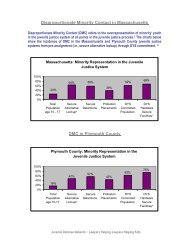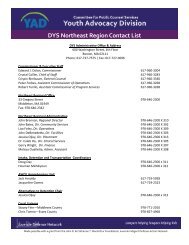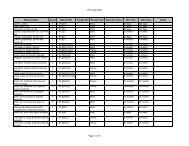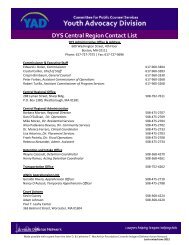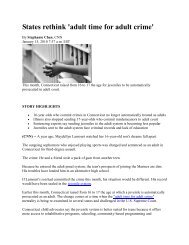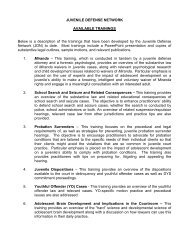Adolescent Brain Development - the Youth Advocacy Division
Adolescent Brain Development - the Youth Advocacy Division
Adolescent Brain Development - the Youth Advocacy Division
Create successful ePaper yourself
Turn your PDF publications into a flip-book with our unique Google optimized e-Paper software.
<strong>Adolescent</strong> <strong>Brain</strong> <strong>Development</strong><br />
Implications in <strong>the</strong> Courtroom<br />
Adolescence has long been known as a time of significant psychosocial development. Recent advances in<br />
fMRI (functional MRI) technology have been critical in understanding adolescence as a crucial period of brain<br />
development. 1 Since <strong>the</strong> science is relatively new, we do not know how it will affect juvenile justice<br />
jurisprudence; a system focused on behavior not anatomy. Science supports <strong>the</strong> notion that anatomy affects<br />
behavior, and as juvenile defenders we need to educate <strong>the</strong> court in this area and use <strong>the</strong> research to<br />
advocate for our clients.<br />
Below are some suggestions on how to use this new brain information in your practice. There are many ways<br />
to utilize <strong>the</strong> research, from pre-trial issues to jury instructions. However, counsel should be aware that <strong>the</strong>re<br />
is no case law in Massachusetts addressing <strong>the</strong> admissibility of brain science testimony and, <strong>the</strong>refore, be<br />
prepared for any objections. We also suggest counsel submit a separate jury instruction on adolescent brain<br />
development in every juvenile trial to highlight that kids are different.<br />
<strong>Brain</strong> <strong>Development</strong> Facts & Implications in <strong>the</strong> Courtroom:<br />
Adolescence is a time of significant neurobiological and psychosocial development, meaning that adolescent<br />
behaviors are less predictive than adult behavior of personality characteristics and future behavior. 2 This fact<br />
can be used in disposition/sentencing to argue that children can be rehabilitated and that long, and<br />
especially adult sentences, are not consistent with research that indicates adolescents behavior can change<br />
and prior behavior is not as predictive of future behavior. Additionally, <strong>the</strong> fact that <strong>the</strong>ir brains are not fully<br />
developed can also be used when seeking relief from <strong>the</strong> sex offender registry, a consequence which<br />
neglects to consider that youth can change <strong>the</strong>ir “criminal” behavior.<br />
<strong>Adolescent</strong> brains undergo a second wave of significant development during <strong>the</strong> teen years, (primarily<br />
concentrated in <strong>the</strong> Frontal Lobe), meaning that <strong>the</strong>ir capacity to make decisions, use judgment, respond to<br />
o<strong>the</strong>rs’ emotions, and assess long-term consequences is immature, and still developing. 3 This fact can be<br />
used as a trial issue and as part of jury instructions. Since adolescents tend to respond to certain stimuli<br />
using <strong>the</strong>ir Amygdala, <strong>the</strong> youth, it can be argued, may not be able to form <strong>the</strong> requisite intent for <strong>the</strong> crime<br />
charged. If you have a client with a history of trauma <strong>the</strong> intent issue, especially in assault type cases, is even<br />
more compelling. Trauma during childhood can become biologically encoded in <strong>the</strong> brain, affecting brain<br />
development. This encoding can impair many functions of <strong>the</strong> brain including memory, reality testing, and<br />
emotional processing, and can cause increased feelings of anxiety, arousal, irritability, depression, and<br />
aggression. The more chronic <strong>the</strong> trauma, <strong>the</strong> stronger <strong>the</strong> impact. 4<br />
Even as <strong>the</strong>ir brains develop, and <strong>the</strong>ir cognitive abilities mature, adolescents continue to display<br />
psychosocial immaturity. <strong>Adolescent</strong>s are more prone to peer pressure, tend to focus on reward over risk, act<br />
impulsively, and are present instead of future oriented. 5 While this is based on developmental research, it is<br />
consistent with adolescent brain research findings and is relevant in joint venture cases.<br />
During adolescence, <strong>the</strong> brain undergoes significant maturation called Myelination, which streamlines <strong>the</strong><br />
connections inside <strong>the</strong> brain, allowing for more reasoned responses. The maturation process is not<br />
completed until young adulthood (perhaps as late as age 25), making <strong>the</strong> brains of adolescents inherently<br />
less capable of balancing <strong>the</strong>ir emotions, and more likely to exhibit risk-taking behavior. 6 This fact is relevant<br />
in crafting conditions of probation that meet your client’s developmental needs. The imposition of multiple<br />
conditions is counterintuitive to what we know about adolescents; <strong>the</strong>y are generally poor decision makers<br />
and lack judgment in assessing long-term consequences.<br />
The Frontal Lobe, often called <strong>the</strong> command center of <strong>the</strong> brain, is not fully developed in adolescents so <strong>the</strong>ir<br />
ability to make decisions, respond to o<strong>the</strong>r people, use reasoned judgment, and assess long-term<br />
consequences is immature and often spontaneous. 7 This is relevant in cases dealing with police<br />
interrogation and waiver of Miranda. Since <strong>the</strong>ir frontal lobes are less developed, adolescents are likely to<br />
be more vulnerable and susceptible to police pressure.<br />
Juvenile Defense Network ~ Lawyers Helping Lawyers Helping Kids





